1mg
Showing 3651–3700 of 3770 results
-
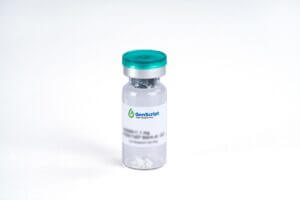
SARS-CoV-2 Nucleocapsid protein (His Tag)
$1,811.25 Add to cart View Product DetailsSARS-CoV-2 (Severe Acute Respiratory Syndrome Coronavirus 2) also known as 2019-nCoV (2019 Novel Coronavirus) is a virus that causes illnesses ranging from the common cold to severe diseases. SARS-CoV-2 Nucleocapsid Protein is associated with nucleic acid. It is the most abundant protein for coronavirus. Because of the strong immunogenicity of coronavirus Nucleocapsid, it is believed that SARS-CoV-2 Nucleocapsid Protein has potential value for the diagnosis of the virus.
-

SARS-CoV-2 Spike (484Q) Antibody (Q8), mAb, Mouse
$1,925.10 Add to cart View Product DetailsSARS-CoV-2 Spike (484Q) Antibody (Q8), mAb, Mouse is specific for 484Q site of B.1.617 SARS-CoV-2. This product can recognize single mutant (E484Q) and double mutant (L452R, E484Q), but can not recognize the wild type and single mutant (L452R).
-

SARS-CoV-2 Spike (E484) Neutralizing Antibody (COV2109)
$2,587.50 Add to cart View Product DetailsThe product is specific for E484 site of wild-type RBD.For specific mutant protein, the product recognizes wild-type RBD, RBD single mutant (N501Y), and RBD single mutant (K417N), but not recognizes RBD single mutant (E484K) and RBD triple mutant (K417N, E484K and N501Y), as seen in Figure 2.
-

SARS-CoV-2 Spike (N501) Neutralizing Antibody (COV2110)
$2,587.50 Add to cart View Product DetailsThe product is specific for N501 site of wild-type RBD.For specific mutant protein, the product recognizes wild-type RBD, RBD single mutant (E484K), and RBD single mutant (K417N), but not recognizes RBD single mutant (N501Y) and RBD triple mutant (K417N, E484K and N501Y), as seen in Figure 2.
-

SARS-CoV-2 Spike protein (ECD, His & Flag Tag)
$1,811.25 Add to cart View Product DetailsSARS-CoV-2 (Severe Acute Respiratory Syndrome Coronavirus 2) also known as 2019-nCoV (2019 Novel Coronavirus) is a virus that causes illnesses ranging from the common cold to severe diseases. SARS-CoV-2 Spike Protein is composed of S1 domain and S2 domain. S1 contains a receptor-binding domain (RBD) that can specifically bind to angiotensin-converting enzyme 2 (ACE2), the receptor on target cells. ECD is the extra cellular domain of spike protein.
-
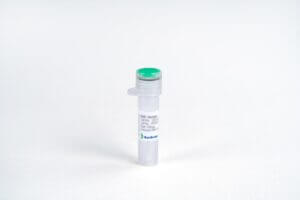
SARS-CoV-2 Spike protein (RBD, E484K, K417N, N501Y, His & Avi Tag)
$1,811.25 Add to cart View Product DetailsSARS-CoV-2 (Severe Acute Respiratory Syndrome Coronavirus 2) also known as 2019-nCoV (2019 Novel Coronavirus) is a virus that causes illnesses ranging from the common cold to severe diseases. SARS-CoV-2 Spike Protein is composed of S1 domain and S2 domain. S1 contains a receptor-binding domain (RBD) that can specifically bind to angiotensin-converting enzyme 2 (ACE2), the receptor on target cells. It is believed that SARS-CoV-2 Spike Protein (RBD) has potential value for the diagnosis of the virus.
-

SARS-CoV-2 Spike protein (RBD, E484K, K417T, N501Y, Avi & His Tag)
$1,811.25 Add to cart View Product DetailsSARS-CoV-2 (Severe Acute Respiratory Syndrome Coronavirus 2) also known as 2019-nCoV (2019 Novel Coronavirus) is a virus that causes illnesses ranging from the common cold to severe diseases. Lineage P.1, also known as the Brazil(ian) variant is one of the variants of SARS-CoV-2. This variant has 17 amino acid changes, ten of which are in its spike protein, including these three designated to be of particular concern: N501Y, E484K and K417T. SARS-CoV-2 Spike protein (RBD, E484K, K417T, N501Y, Avi & His Tag) carries a Avi Tag followed by a polyhistidine tag at the C-terminus. It has high binding affinity to human chimeric ACE2.
-

SARS-CoV-2 Spike protein (RBD, His & Avi tag)
$1,811.25 Add to cart View Product DetailsSARS-CoV-2 (Severe Acute Respiratory Syndrome Coronavirus 2) also known as 2019-nCoV (2019 Novel Coronavirus) is a virus that causes illnesses ranging from the common cold to severe diseases. SARS-CoV-2 Spike Protein is composed of S1 domain and S2 domain. S1 contains a receptor-binding domain (RBD) that can specifically bind to angiotensin-converting enzyme 2 (ACE2), the receptor on target cells. It is believed that SARS-CoV-2 Spike Protein (RBD) has potential value for the diagnosis of the virus.
-

SARS-CoV-2 Spike protein (RBD, His Tag)
$1,811.25 Add to cart View Product DetailsSARS-CoV-2 (Severe Acute Respiratory Syndrome Coronavirus 2) also known as 2019-nCoV (2019 Novel Coronavirus) is a virus that causes illnesses ranging from the common cold to severe diseases. SARS-CoV-2 Spike Protein is composed of S1 domain and S2 domain. S1 contains a receptor-binding domain (RBD) that can specifically bind to angiotensin-converting enzyme 2 (ACE2), the receptor on target cells. It is believed that SARS-CoV-2 Spike Protein (RBD) has potential value for the diagnosis of the virus.
-

SARS-CoV-2 Spike protein (RBD, L452R, T478K, Avi & His Tag)
$1,811.25 Add to cart View Product DetailsSARS-CoV-2 (Severe Acute Respiratory Syndrome Coronavirus 2) also known as 2019-nCoV (2019 Novel Coronavirus) is a virus that causes illnesses ranging from the common cold to severe diseases. As of May 2021, three sublineages have been found. Despite its name, B.1.617.3 was the first sublineage of this variant to be detected, in October 2020 in India. This sublineage has remained relatively uncommon compared to the two other sublineages, B.1.617.1 (also known as variant Kappa) and B.1.617.2 (also known as variant Delta), both of which were first detected in December 2020. This variant has the double mutations E484Q and L452R in the spike proteins. Emerging research suggests the variant may be more transmissible than previously evolved ones. Whether the effectiveness of currently-deployed vaccines is affected remains under investigation. Moreover, the sublineage B.1.617.2 has been redesignated as “variant of concern” (VOC-21APR-02) in May 2021, which spreads more quickly than the original version of the virus.
-

SARS-CoV-2 Spike protein (RBD, mFc Tag, CHO-expressed)
$1,811.25 Add to cart View Product DetailsSARS-CoV-2 (Severe Acute Respiratory Syndrome Coronavirus 2) also known as 2019-nCoV (2019 Novel Coronavirus) is a virus that causes illnesses ranging from the common cold to severe diseases. SARS-CoV-2 Spike Protein is composed of S1 domain and S2 domain. S1 contains a receptor-binding domain (RBD) that can specifically bind to angiotensin-converting enzyme 2 (ACE2), the receptor on target cells. It is believed that SARS-CoV-2 Spike Protein (RBD) has potential value for the diagnosis of the virus.
-

SARS-CoV-2 Spike protein (RBD, mFc Tag)
$1,811.25 Add to cart View Product DetailsSARS-CoV-2 (Severe Acute Respiratory Syndrome Coronavirus 2) also known as 2019-nCoV (2019 Novel Coronavirus) is a virus that causes illnesses ranging from the common cold to severe diseases. SARS-CoV-2 Spike Protein is composed of S1 domain and S2 domain. S1 contains a receptor-binding domain (RBD) that can specifically bind to angiotensin-converting enzyme 2 (ACE2), the receptor on target cells. It is believed that SARS-CoV-2 Spike Protein (RBD) has potential value for the diagnosis of the virus.
-

SARS-CoV-2 Spike protein (RBD, N501Y, His & Avi Tag)
$1,811.25 Add to cart View Product DetailsSARS-CoV-2 (Severe Acute Respiratory Syndrome Coronavirus 2) also known as 2019-nCoV (2019 Novel Coronavirus) is a virus that causes illnesses ranging from the common cold to severe diseases. The spike protein mutation N501Y is one of six key contact residues within the receptor-binding domain (RBD) and has been identified as increasing binding affinity to human and murine ACE2.
-

SARS-CoV-2 Spike protein (S1, D614G, His Tag)
$1,811.25 Add to cart View Product DetailsSARS-CoV-2 (Severe Acute Respiratory Syndrome Coronavirus 2) also known as 2019-nCoV (2019 Novel Coronavirus) is a virus that causes illnesses ranging from the common cold to severe diseases. The spike protein mutation D614G became dominant during the globally pandemic. The D614G mutation enhances its replication ability in upper respiratory tract, transmission ability and viral loads in the patients’ lung epithelial cells. It may also affect vaccine efficacy and antibody therapy.
-

SARS-CoV-2 Spike protein (S1, His Tag, CHO-expressed)
$1,811.25 Add to cart View Product DetailsSARS-CoV-2 (Severe Acute Respiratory Syndrome Coronavirus 2) also known as 2019-nCoV (2019 Novel Coronavirus) is a virus that causes illnesses ranging from the common cold to severe diseases. SARS-CoV-2 Spike Protein is composed of S1 domain and S2 domain. S1 contains a receptor-binding domain (RBD) that can specifically bind to angiotensin-converting enzyme 2 (ACE2), the receptor on target cells. S protein plays an important role in the induction of neutralizing antibodies and T-cell responses, as well as protective immunity.
-

SARS-CoV-2 Spike protein (S1, His Tag)
$1,811.25 Add to cart View Product DetailsSARS-CoV-2 (Severe Acute Respiratory Syndrome Coronavirus 2) also known as 2019-nCoV (2019 Novel Coronavirus) is a virus that causes illnesses ranging from the common cold to severe diseases. SARS-CoV-2 Spike Protein is composed of S1 domain and S2 domain. S1 contains a receptor-binding domain (RBD) that can specifically bind to angiotensin-converting enzyme 2 (ACE2), the receptor on target cells. S protein plays an important role in the induction of neutralizing antibodies and T-cell responses, as well as protective immunity.
-

SARS-CoV-2 Spike protein (S1, T19R, G142D, del 156-157, R158G, L452R, T478K, D614G, P681R, His Tag)
$1,811.25 Add to cart View Product DetailsSARS-CoV-2 (Severe Acute Respiratory Syndrome Coronavirus 2) also known as 2019-nCoV (2019 Novel Coronavirus) is a virus that causes illnesses ranging from the common cold to severe diseases. As of May 2021, three sublineages have been found. Despite its name, B.1.617.3 was the first sublineage of this variant to be detected, in October 2020 in India. This sublineage has remained relatively uncommon compared to the two other sublineages, B.1.617.1 (also known as variant Kappa) and B.1.617.2 (also known as variant Delta), both of which were first detected in December 2020. This variant has the double mutations E484Q and L452R in the spike proteins. Emerging research suggests the variant may be more transmissible than previously evolved ones. Whether the effectiveness of currently-deployed vaccines is affected remains under investigation. Moreover, the sublineage B.1.617.2 has been redesignated as “variant of concern” (VOC-21APR-02) in May 2021, which spreads more quickly than the original version of the virus.
-

SARS-CoV-2 Spike protein (S1)
$1,811.25 Add to cart View Product DetailsSARS-CoV-2 (Severe Acute Respiratory Syndrome Coronavirus 2) also known as 2019-nCoV (2019 Novel Coronavirus) is a virus that causes illnesses ranging from the common cold to severe diseases. SARS-CoV-2 Spike Protein is composed of S1 domain and S2 domain. S1 contains a receptor-binding domain (RBD) that can specifically bind to angiotensin-converting enzyme 2 (ACE2), the receptor on target cells. S protein plays an important role in the induction of neutralizing-antibodies and T-cell responses, as well as protective immunity.
-

SARS-CoV-2 Spike protein RBD, Omicron Variant, His Tag
$2,070.00 Add to cart View Product DetailsSARS-CoV-2 (Severe Acute Respiratory
Syndrome Coronavirus 2) also known as 2019-nCoV (2019 Novel Coronavirus) is a virus that causes illnesses ranging from the common cold to severe diseases. Recently, the new B.1.1.529 variant was confirmed in South Africa and preliminary evidence suggests an increased risk of reinfection with this variant. The B.1.1.529 variant was first reported to WHO on 24 November 2021 and WHO has designated this variant as a VOC (Variant of Concern), named Omicron. There are more than 30 mutations in the spike protein. -

SARS-CoV-2 Spike protein S1, Omicron Variant, His Tag
$1,811.25 Add to cart View Product DetailsSARS-CoV-2 (Severe Acute Respiratory
Syndrome Coronavirus 2) also known as 2019-nCoV (2019 Novel Coronavirus) is a virus that causes illnesses ranging from the common cold to severe diseases. Recently, the new B.1.1.529 variant was confirmed in South Africa and preliminary evidence suggests an increased risk of reinfection with this variant. The B.1.1.529 variant was first reported to WHO on 24 November 2021 and WHO has designated this variant as a VOC (Variant of Concern), named Omicron. There are more than 30 mutations in the spike protein. -
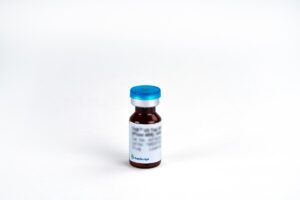
SARS-CoV-2 Spike S1 Antibody (HC2001), Human Chimeric
$2,587.50 Add to cart View Product DetailsThe product is specific for SARS-CoV-2 Spike Protein S1 subunit and its RBD domain.
-

SARS-CoV-2 Spike S1 Antibody (hIgA2001), Human Chimeric
$2,960.10 Add to cart View Product DetailsThe product is specific for SARS-CoV-2 Spike Protein S1 subunit and its RBD domain.
-
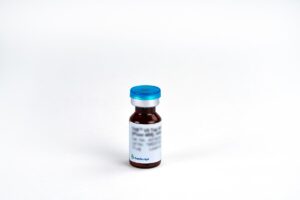
SARS-CoV-2 Spike S1 Antibody (hIgM2001), Human Chimeric
$2,960.10 Add to cart View Product DetailsThe product is specific for SARS-CoV-2 Spike Protein S1 subunit and its RBD domain.
-
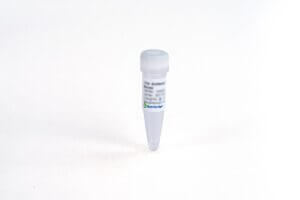
SCC (SC1), mAb, Mouse
$307.05 Add to cart View Product DetailsSquamous
cell carcinoma antigen (SCCA) is one protein member of the serine protease
inhibitor (Serpin) family. Expression of SCCA is elevated in cancers of the cervix, lung, head and neck, and liver. As a result,
it is a useful biomarker for aggressive squamous cell carcinoma (SCC). -

SCC (SC9), mAb, Mouse
$307.05 Add to cart View Product DetailsSquamous
cell carcinoma antigen (SCCA) is one protein member of the serine protease
inhibitor (Serpin) family. Expression of SCCA is elevated in cancers of the cervix, lung, head and neck, and liver. As a result,
it is a useful biomarker for aggressive squamous cell carcinoma (SCC). -

SCCA Antibody (SC4), mAb, Mouse
$318.26 Add to cart View Product DetailsSquamous
cell carcinoma antigen (SCCA) is one protein member of the serine protease
inhibitor (Serpin) family. Expression of SCCA is elevated in cancers of the cervix, lung, head and neck, and liver. As a result,
it is a useful biomarker for aggressive squamous cell carcinoma (SCC) -

sCD40L, Human
$1,030.69 Add to cart View Product DetailsCD40 ligand, CD40L (also known as CD154, TRAP or gp39), is a 261 amino acid type II transmembrane glycoprotein belonging to the TNF family, CD40L is expressed predominantly on activated CD4+ T lymphocytes, and also found in other types of cells, like NK cells, mast cells, basophils and eosinophils. Human CD40L shares 78% amino acid identity with its mouse counterpart. The receptor of CD40L is CD40, a type I transmembrane glycoprotein belonging to the TNF receptor family. CD40 is expressed on B lymphocytes, monocytes, dendritic cells and thymic epithelium. Although all monomeric, dimeric and trimeric forms of soluble CD40L can bind to CD40, the trimeric form of soluble CD40L has the most potent biological activity through oligomerization of cell surface CD40, a common feature of TNF receptor family members. CD40L mediates a range of activities on B cells including induction of activation-associated surface antigen, entry into cell cycle, isotype switching and Ig secretion and memory generation. CD40-CD40L interaction also plays important roles in monocyte activation and dendritic cell maturation.
-

SCF, Human (P. pastoris-expressed)
$1,177.31 Add to cart View Product DetailsStem cell factor (also known as SCF, KIT-ligand, KL, or steel factor) is a cytokine that binds to the c-KIT receptor (CD117). SCF can exist both as a transmembrane protein and a soluble protein. It stimulates the proliferation of myeloid, erythroid, and lymphoid progenitors in bone marrow cultures and has been shown to act synergistically with colony stimulating factors. SCF plays an important role in the hematopoiesis during embryonic development. SCF can regulates HSCs in the stem cell niche in the bone marrow. SCF has been shown to increase the survival of HSCs in vitro and contributes to the self-renewal and maintenance of HSCs in-vivo.
-

SCF, Mouse
$1,177.31 Add to cart View Product DetailsStem cell factor (also known as SCF, KIT-ligand, KL, or steel factor) is a cytokine that binds to the c-KIT receptor (CD117). SCF can exist both as a transmembrane protein and a soluble protein. It stimulates the proliferation of myeloid, erythroid, and lymphoid progenitors in bone marrow cultures and has been shown to act synergistically with colony stimulating factors. SCF plays an important role in the hematopoiesis during embryonic development. SCF can regulates HSCs in the stem cell niche in the bone marrow. SCF has been shown to increase the survival of HSCs in vitro and contributes to the self-renewal and maintenance of HSCs in-vivo.
-

SDF-1α/CXCL12, Human
$2,018.25 Add to cart View Product DetailsStromal-Cell Derived Factor-1 alpha/ CXCL12 (SDF-1α) and SDF-1β, members of the chemokine α subfamily that lack the ELR domain, were initially identified using the signal sequence trap cloning strategy from a mouse bone-marrow stromal cell line. These proteins were subsequently also cloned from a human stromal cell line as cytokines that supported the proliferation of a stromal cell-dependent pre-B-cell line. SDF-1α and SDF-1β cDNAs encode precursor proteins of 89 and 93 amino acid residues, respectively. Both SDF-1α and SDF-1β are encoded by a single gene and arise by alternative splicing. The two proteins are identical except for the four amino acid residues that are present in the carboxy-terminus of SDF-1β and absent from SDF-1α. SDF-1/PBSF is highly conserved between species, with only one amino acid substitution between the mature human and mouse proteins. SDF-1/PBSF acts via the chemokine receptor CXCR4 and has been shown to be a chemoattractant for T-lymphocytes, monocytes, pro- and pre- B cells, but not neutrophils. Mice lacking SDF-1 or CXCR4 have been found to have impaired B-lymphopoiesis, myelopoiesis, vascular development, cardiogenesis and abnormal neuronal cell migration and patterning in the central nervous system.
-

SDF-1β/CXCL12, Human
$2,018.25 Add to cart View Product DetailsStromal-Cell Derived Factor-1 beta (SDF-1β), also known as SCYB12, PBSF and CXCL12, is an 8.3 kDa, heparin-binding member of the CXC (or alpha) family of chemokines and signal through the CXCR4 receptor. SDF-1α and β are reported to be monomers at neutral pH and physiologic ionic strength, On the cell surface, this may well facilitate SDF-1 interaction with its two receptors, CXCR4 and syndecan4. Heparin sulfate is known to protect SDF-1 from proteolysis, and CXCR4 exists constitutively as a dimer. Among its many functions, CXCL12 is known to influence lymphopoiesis, regulate patterning and cell number of neural progenitors, and promote angiogenesis (12, 13). It also enhances the survival of myeloid progenitor cells
-

Shh (C24II), Human
$1,177.31 Add to cart View Product DetailsSonic Hedgehog (Shh) is a member of the Hedgehog (Hh) family of highly conserved proteins which are widely represented throughout the animal kingdom. In mammal, there are three related Hh proteins, Sonic (Shh), Desert (Dhh) and Indian (Ihh). They share a high degree of amino-acid sequence identity (e.g., Shh and Ihh are 93% identical). Sonic Hedgehog plays a role in cell growth, cell specialization, and the normal shaping (patterning) of the body. Shh is also important for development of the brain and spinal cord (central nervous system), eyes, limbs, and many other parts of the body.
-

Shh (C25II), Mouse
$1,177.31 Add to cart View Product DetailsSonic Hedgehog (Shh) is a member of the Hedgehog (Hh) family of highly conserved proteins which are widely represented throughout the animal kingdom. In mammal, there are three related Hh proteins, Sonic (Shh), Desert (Dhh) and Indian (Ihh). They share a high degree of amino-acid sequence identity (e.g., Shh and Ihh are 93% identical). Sonic Hedgehog plays a role in cell growth, cell specialization, and the normal shaping (patterning) of the body. Shh is also important for development of the brain and spinal cord (central nervous system), eyes, limbs, and many other parts of the body.
-

Shh, Human
$1,957.88 Add to cart View Product DetailsMembers of the Hedgehog (Hh) family are highly conserved proteins which are widely represented throughout the animal kingdom. The three known mammalian Hh proteins, Sonic (Shh), Desert (Dhh) and Indian (Ihh) are structurally related and share a high degree of amino-acid sequence identity (e.g., Shh and Ihh are 93% identical). The biologically active form of Hh molecules is obtained by autocatalytic cleavage of their precursor proteins and corresponds to approximately the N-terminal one half of the precursor molecule. Although Hh proteins have unique expression patterns and distinct biological roles within their respective regions of secretion, they use the same signaling pathway and can substitute for each other in experimental systems.
-
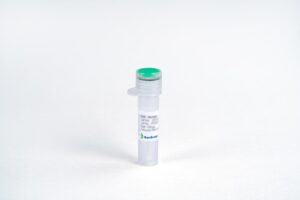
Shh, Mouse
$1,177.31 Add to cart View Product DetailsMembers of the Hedgehog (Hh) family are highly conserved proteins which are widely represented throughout the animal kingdom. The three known mammalian Hh proteins, Sonic (Shh), Desert (Dhh) and Indian (Ihh) are structurally related and share a high degree of amino-acid sequence identity (e.g., Shh and Ihh are 93% identical). The biologically active form of Hh molecules is obtained by autocatalytic cleavage of their precursor proteins and corresponds to approximately the N-terminal one half of the precursor molecule. Although Hh proteins have unique expression patterns and distinct biological roles within their respective regions of secretion, they use the same signaling pathway and can substitute for each other in experimental systems.
-

Siglec-10 Fc Chimera, Human
$1,293.75 Add to cart View Product DetailsSiglec-10 is immune system-restricted and highly expressed in peripheral blood leukocytes. Siglec-10 preferably binds to α-2,3- or α-2,6-linked sialic acid (similarity). Siglec10 is involved in the negative regulation of B cell antigen receptor signal transduction. The inhibition of B cell activation depends on PTPN6/SHP-1 (by similarity). The binding of Siglec10 to CD24 may be involved in the selective suppression of the immune response (by similarity) to risk-related molecular patterns (DAMPs) (such as HMGB1, HSP70 and HSP90). The combination of Siglec10 and CD24 may regulate the immune response of natural killer (NK) cells. Play a role in controlling autoimmunity (by similarity). In the process of initiating an adaptive immune response by CD8-α+ dendritic cells, cross-presentation is inhibited by weakening the formation of MHC class I peptide complexes. The function seems to imply the recruitment of PTPN6/SHP-1, which dephosphorylates NCF1 of the NADPH oxidase complex, thereby promoting phagosome acidification (by similarity).
-

Siglec-15 Fc Chimera, Human
$1,293.75 Add to cart View Product DetailsSiglec-15 preferentially recognizes the Neu5Acalpha2-6GalNAcalpha- structure. Siglec-15 associates with the activating adaptor proteins DNAX activation protein (DAP)12 and DAP10 via its lysine residue in the transmembrane domain. Siglec-15 is the second human Siglec identified to have an activating signaling potential; unlike Siglec-14, however, it does not have an inhibitory counterpart.
-

sIL-6Rα, His, Human
$1,470.56 Add to cart View Product DetailsInterleukin-6 Receptor (IL-6R) is a single trans-membrane protein that is the receptor for Interleukin-6 (IL-6). IL-6R forms a hexameric complex upon binding 2 molecules of IL-6 and two molecules of glycoprotein 130 (gp130) which activates intracellular JAK/STAT pathways. Although the normal form of IL-6R is the membrane-bound 80 kDa subunit, a soluble form of IL-6R (sIL-6R) can be generated physiologically by limited proteolysis or alternative splicing. sIL-6R binds to both IL-6 and gp130 generating intracellular signaling. In the immune system, sIL-6R is produced by both naïve and memory CD4 T-cells and strongly augments IL-6 ligand’s induction of Th-17 cells.
-
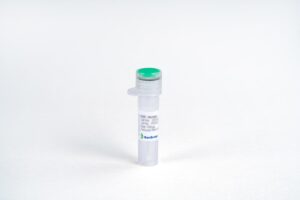
SIRPα Fc Chimera, Human
$1,035.00 Add to cart View Product DetailsSignal regulatory protein alpha (SIRPα, designated CD172a), is also known as CD172 antigen-like family member A (CD172a), also called SHPS-1 (SHP substrate 1) and previously, MyD-1 (Myeloid/Dendritic-1), which is a monomeric about 90kDa type I transmembrane glycoprotein that belongs to the SIRP/SHPS (CD172) family of the immunoglobulin superfamily. SIRPα is Ubiquitous and highly expressed in brain. SIRPA/CD172a is immunoglobulin-like cell surface receptor for CD47 and acts as docking protein and induces translocation of PTPN6, PTPN11 and other binding partners from the cytosol to the plasma membrane. SIRPA/SHPS-1 supports adhesion of cerebellar neurons, neurite outgrowth and glial cell attachment and may play a key role in intracellular signaling during synaptogenesis and in synaptic function by similarity. SIRPα recognition of surfactants SP-A and SP-D in the lung can inhibit alveolar macrophage cytokine production.
-
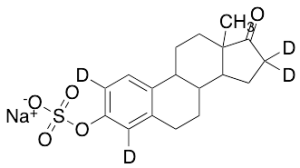
Sodium Estrone-2,4,16,16-d4 Sulfate (Stabilized with TRIS, 50% w/w)
$55.20 Add to cart View Product DetailsMolecular Formula : C18 2H4 H17 O5 S . Na
-
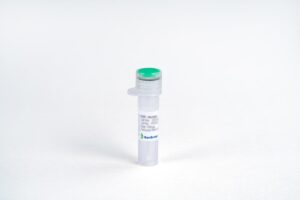
SPARC, Human
$1,224.75 Add to cart View Product DetailsSPARC, an acronym for ’secreted protein, acidic and rich in cysteine’, is also known as osteonectin or BM-40. It is the founding member of a family of secreted matricellular proteins with similar domain structure. The 303 amino acid , 43 kDa protein contains a 17 aa signal sequence, an N-terminal acidic region that binds calcium, a follistatin domain containing Kazal-like sequences, and a C-terminal extracellular calcium (EC) binding domain with two EF-hand motifs. SPARC is produced by fibroblasts, capillary endothelial cells, platelets and macrophages, especially in areas of tissue morphogenesis and remodeling. SPARC shows context-specific effects, but generally inhibits adhesion, spreading and proliferation, and promotes collagen matrix formation. For endothelial cells, SPARC disrupts focal adhesions and binds and sequesters PDGF and VEGF. SPARC is abundantly expressed in bone, where it promotes osteoblast differentiation and inhibits adipogenesis.
-

ST2 (16G5), mAb, Mouse
$144.04 Add to cart View Product DetailsSuppression of Tumorigenicity 2 (ST2), a member of the Interleukin-1 receptor family, has two isoforms, one is soluble form (sST2) and the other one is transmembrane form (ST2L). sST2, lacking the transmembrane and intracellular domains, can prevent the interaction between IL-33 and ST2L. It plays a role in inflammatory and immune processes and is considered as a promising marker for myocardial stress.
-

ST2 (6B3), mAb, Mouse
$144.04 Add to cart View Product DetailsSuppression of Tumorigenicity 2 (ST2), a member of the Interleukin-1 receptor family, has two isoforms, one is soluble form (sST2) and the other one is transmembrane form (ST2L). sST2, lacking the transmembrane and intracellular domains, can prevent the interaction between IL-33 and ST2L. It plays a role in inflammatory and immune processes and is considered as a promising marker for myocardial stress.
-

ST2 (8H6), mAb, Mouse
$144.04 Add to cart View Product DetailsSuppression of Tumorigenicity 2 (ST2), a member of the Interleukin-1 receptor family, has two isoforms, one is soluble form (sST2) and the other one is transmembrane form (ST2L). sST2, lacking the transmembrane and intracellular domains, can prevent the interaction between IL-33 and ST2L. It plays a role in inflammatory and immune processes and is considered as a promising marker for myocardial stress.
-

Staphylokinase
$625.31 Add to cart View Product DetailsStaphylokinase (SAK), a 16kDa profibrinolytic protein from the Staphylococcus aureus, has been demonstrated to induce highly fibrin-specific thrombolysis in both human plasma and in limited clinical trials. Recent studies on the thrombolytic potential of recombinant SAK in achieving early perfusion in myocardial infarction and in the dissolution of platelet-rich clot have clearly established its immense utility in clinical medicine as a thrombolytic agent and suggested that it can be developed as a potent clot-dissolving agent.
-
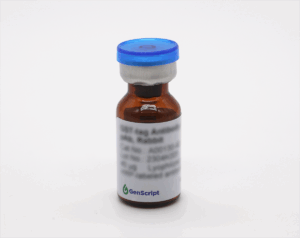
Streptavidin-HRP
$81.94 Add to cart View Product DetailsStreptavidin is a protein that has similar binding properties to avidin. It is isolated from streptomyces avidinii. Streptavidin has a molecular weight of 60 KD and has 4 subunits. Each subunit can bind one molecule of biotin. Biotin is a 244 da water soluble vitamin. Streptavidin has an extremely high binding affinity (Kd=10 – 15 ) for biotin.
Streptavidin – HRP (M00091) is a HRP conjugated streptavidin and can be used for analysis of biotinylated molecules. -

T-705RTP Sodium Salt (>75%)
$961.69 Add to cart View Product DetailsMolecular Formula : C10 H15 F N3 O15 P3 . xNa
-

T3 (HCT3)
$125.06 Add to cart View Product DetailsT3, also known as Triiodothyronine, is a thyroid hormone. It plays a key role in controlling body weight, body temperature, muscle strength, and nervous system. T3 is secreted by thyroid. In the blood, elevation of T3 level inhibits the production of TSH in the anterior pituitary gland.
-
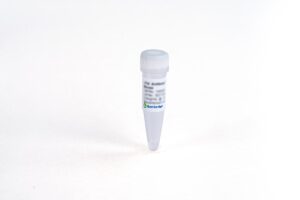
T4 (HCT4)
$125.06 Add to cart View Product DetailsT4,
also known as Thyroxine, is a type of thyroid hormone. It exists in the blood as an equilibrium mixture
of free and serum bound hormone. It plays an important role in regulating body
weight, body temperature, muscle strength, and even your mood. T4 is useful to
diagnose disorders of the thyroid -

TARC/CCL17, Human
$2,190.75 Add to cart View Product DetailsCCL17 is a novel CC chemokine recently identified using a signal sequence trap method. CCL17 cDNA encodes a highly basic 94 amino acid residue precursor protein with a 23 aa residue signal peptide that is cleaved to generate the 71 aa residue mature secreted protein. Among CC chemokine family members, CCL17 has approximately 24 – 29% amino acid sequence identity with RANTES, MIP-1α, MIP-1β, MCP-1, MCP-2, MCP-3 and I-309. The gene for human CCL17 has been mapped to chromosome 16q13 rather than chromosome 17 where the genes for many human CC chemokines are clustered. CCL17 is constitutively expressed in thymus, and at a lower level in lung, colon, and small intestine. CCL17 is also transiently expressed in stimulated peripheral blood mononuclear cells.






